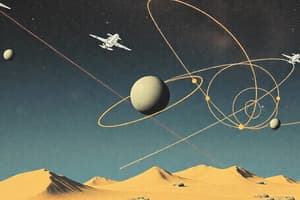Podcast
Questions and Answers
What is the main difference between Newton's and Einstein's theories of gravity?
What is the main difference between Newton's and Einstein's theories of gravity?
- Newton's theory is a curvature of spacetime, while Einstein's theory is a force.
- Newton's theory applies only to large objects, while Einstein's theory applies to all objects.
- Newton's theory is a force, while Einstein's theory is a curvature of spacetime. (correct)
- Newton's theory applies only to small objects, while Einstein's theory applies to all objects.
What is the mathematical formulation for the force of gravity in Newton's theory?
What is the mathematical formulation for the force of gravity in Newton's theory?
- F = G \* (m1 - m2) / r
- F = G \* (m1 + m2) / r
- F = G \* (m1 \* m2) / r^2 (correct)
- F = G \* (m1 \* m2) / r
What is the name of the tensor that describes the curvature of spacetime in Einstein's theory?
What is the name of the tensor that describes the curvature of spacetime in Einstein's theory?
- Riemann tensor
- Stress-energy tensor
- Metric tensor
- Ricci tensor (correct)
What is the characteristic of a black hole?
What is the characteristic of a black hole?
What is the mathematical formulation for the Schwarzschild metric?
What is the mathematical formulation for the Schwarzschild metric?
What is the mathematical formulation for the strain of a gravitational wave?
What is the mathematical formulation for the strain of a gravitational wave?
What is the name of the organization that detected gravitational waves directly for the first time?
What is the name of the organization that detected gravitational waves directly for the first time?
What is the term for the curvature of spacetime caused by massive objects?
What is the term for the curvature of spacetime caused by massive objects?
Study Notes
Gravity
Newton's Theory of Gravity
- Introduced by Sir Isaac Newton in 1687
- Gravity is a universal force that attracts two objects with mass
- Force of gravity is proportional to the product of the two masses and inversely proportional to the square of the distance between them
- Mathematical formulation:
- F = G * (m1 * m2) / r^2
- Where F is the force of gravity, G is the gravitational constant, m1 and m2 are the masses, and r is the distance between them
Einstein's Theory of Gravity
- Introduced by Albert Einstein in 1915
- Gravity is not a force, but the curvature of spacetime caused by massive objects
- Massive objects warp spacetime around them, and other objects follow geodesic paths, which we experience as gravity
- Mathematical formulation:
- Rμν - 1/2Rgμν = (8πG/c^4)Tμν
- Where Rμν is the Ricci tensor, R is the Ricci scalar, gμν is the metric tensor, G is the gravitational constant, c is the speed of light, and Tμν is the stress-energy tensor
Black Holes
- Regions of spacetime where gravity is so strong that not even light can escape
- Formed when a massive star collapses in on itself
- Characterized by their mass, charge, and angular momentum
- Mathematical formulation:
- Schwarzschild metric: ds^2 = (1 - 2GM/r)dt^2 - (1 - 2GM/r)^{-1}dr^2 - r^2dθ^2 - r^2sin^2θdφ^2
- Where G is the gravitational constant, M is the mass of the black hole, and r is the radial distance from the center
Gravitational Waves
- Ripples in spacetime produced by the acceleration of massive objects
- Predicted by Einstein's theory of general relativity
- Detected directly for the first time in 2015 by LIGO
- Mathematical formulation:
- h = (2G/c^4) * (1/r) * (d^2Q/dt^2)
- Where h is the strain of the gravitational wave, G is the gravitational constant, c is the speed of light, r is the distance from the source, and Q is the quadrupole moment of the source
Gravity
- Gravity is a universal force that attracts two objects with mass, introduced by Sir Isaac Newton in 1687
- Newton's law of gravity states that the force of gravity is proportional to the product of the two masses and inversely proportional to the square of the distance between them
- Mathematical formulation of Newton's law: F = G * (m1 * m2) / r^2
Einstein's Theory of Gravity
- Albert Einstein introduced his theory of gravity in 1915, stating that gravity is not a force, but the curvature of spacetime caused by massive objects
- Massive objects warp spacetime around them, and other objects follow geodesic paths, which we experience as gravity
- Mathematical formulation of Einstein's theory: Rμν - 1/2Rgμν = (8πG/c^4)Tμν
Black Holes
- Black holes are regions of spacetime where gravity is so strong that not even light can escape
- Formed when a massive star collapses in on itself, characterized by their mass, charge, and angular momentum
- Described by the Schwarzschild metric: ds^2 = (1 - 2GM/r)dt^2 - (1 - 2GM/r)^{-1}dr^2 - r^2dθ^2 - r^2sin^2θdφ^2
Gravitational Waves
- Gravitational waves are ripples in spacetime produced by the acceleration of massive objects, predicted by Einstein's theory of general relativity
- Detected directly for the first time in 2015 by LIGO, with a mathematical formulation: h = (2G/c^4) * (1/r) * (d^2Q/dt^2)
Studying That Suits You
Use AI to generate personalized quizzes and flashcards to suit your learning preferences.
Description
Explore the fundamental principles of gravity, including Newton's Law of Universal Gravitation and Einstein's Theory of General Relativity. Learn about the forces that shape our universe.




